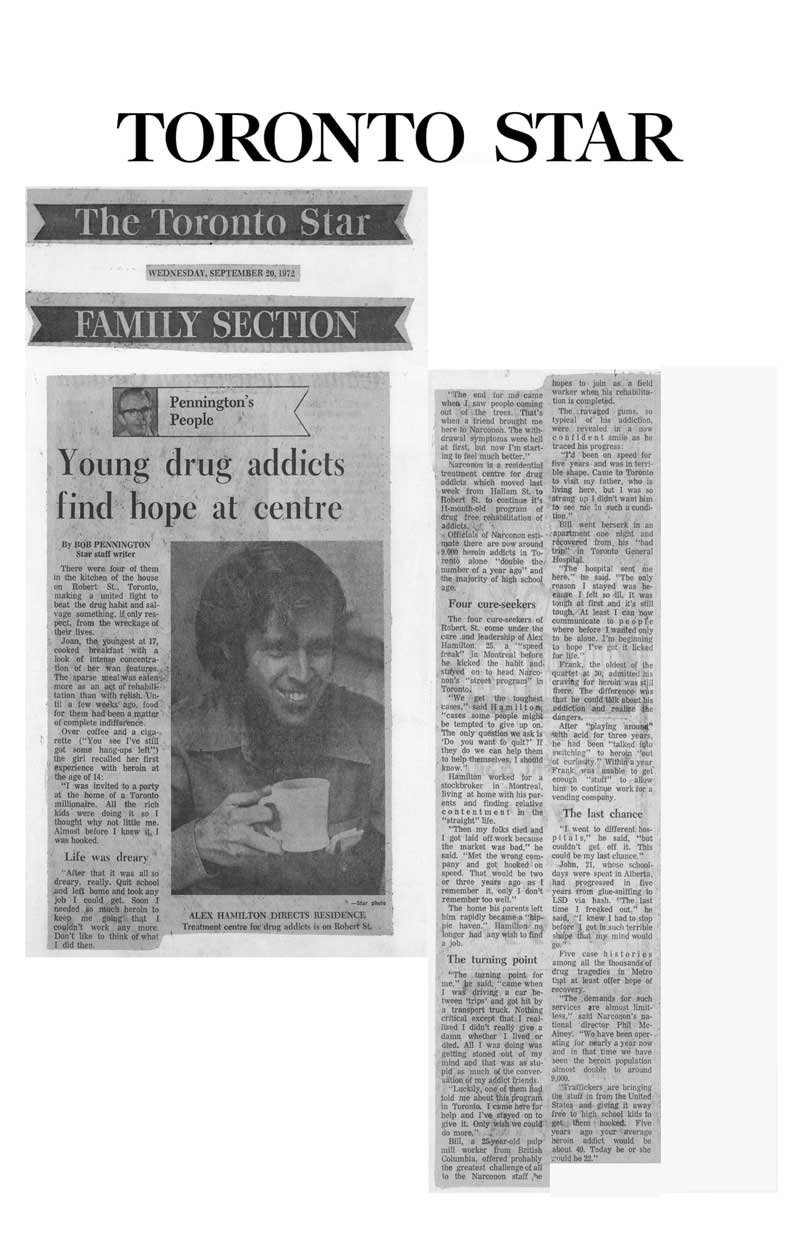
Young Drug Addicts Find Hope at Narconon Centre
There were four of them in the kitchen of the house on Robert St., Toronto, making a united fight to beat the drug habit and salvage something, if only respect, from the wreckage of their lives.
Joan, the, youngest at 17, cooked breakfast with a look of intense concentration on her wan features. The sparse meal was eaten more as an act of rehabilitation than with relish. Until a few weeks ago, food for them had been a matter of complete indifference.
Over coffee and a cigarette (“You see I’ve still got some hang-ups left”) the girl recalled her first experience with heroin at the age of 14:
“I was invited to a party at the home of a Toronto millionaire. All the rich kids were doing it so I thought why not little me. Almost before I knew it, I was hooked.
Life was Dreary
“After that it was all so dreary, really. Quit school and left home and took any job I could get. Soon I needed so much heroin to keep me going that I couldn’t work any more. Don’t like to think of what I did then.
“The end for me came when I saw people coming out of the trees. That’s when a friend brought me here to Narconon. The withdrawal symptoms were hell at first, but now I’m starting to feel much better.”
Narconon is a residential treatment centre for drug addicts which moved last week, from Hallam St. to Robert St. to continue its 11-month-o1d program of drug free rehabilitation of addicts.
Officials of Narconon estimate there are now around 9,000 heroin addicts in Toronto alone “double the number of a year ago” and the majority of high school age.
Four Cure-Seekers
The four cure-seekers of Robert St. come under the care and leadership of Alex Hamilton, 25, a “speed freak” in Montreal before he kicked the habit and stayed on to head Narconon’s “street program” in Toronto.
“We get the toughest cases”, said Hamilton, “cases some people might be tempted to give up on. The only question we ask is ‘Do you want to quit?’ If they do we can help them to help themselves. I should know.”
Hamilton worked for a stockbroker in Montreal, living at home with his parents and finding relative contentment in the “straight” life.
“Then my folks died and I got laid off work because the market was bad,” he said. “Met the wrong company and got hooked on speed. That would be two or three years ago as I remember it, only I don’t remember too well.”
The home his parents left him rapidly became a “hippie haven.” Hamilton no longer had any wish to find a job.
The Turning Point
“The turning point for me,” he said, “came when I was driving a car between ‘trips’ and got hit by a transport truck. Nothing critical except that I realized I didn’t really give a damn whether I lived or died. All I was doing was getting stoned out of my mind and that was as stupid as much of the conversation with my addict friends.
“Luckily, one of them told me about this program in Toronto. I came here for help and I stayed on to give it. Only wish we could do more.”
Bill, a 25-year-old pulp mill worker from British Columbia, offered probably the greatest challenge of all to the Narconon staff he hopes to join as a field worker when his rehabilitation is completed.
The ravaged gums, so typical of his addiction, were revealed in a now confident smile as he traced his progress:
“I’d been on speed for five years and was in terrible shape. Came to Toronto to visit my father, who is living here, but I was so strung up I didn’t want him to see me in such a condition.”
Bill went berserk in an apartment one night and recovered from his “bad trip” in Toronto General Hospital.
“The hospital sent me here,” he said. “The only reason I stayed was because I felt so ill. It was tough at first and it’s still tough. At least I can now communicate to people where before I wanted only to be alone. I’m beginning to hope I’ve got it licked for life.”
Frank, the o1dest of the quartet at 30, admitted his craving for heroin was still there. The difference was that he could talk about his addiction and realize the dangers.
After “playing around” with acid for three years, he had been “talked into switching” to heroin “out of curiosity.” Within a year Frank was unable to get enough “stuff” to allow him to continue work for a vending company.
The Last Chance
“I went to different hospitals,” he said, “but couldn’t get off it. This could be my last chance.”
John, 21, whose school days were spent in Alberta, had progressed in five years from glue-sniffing to LSD via hash. “The last time I freaked out,” he said, “I knew I had to stop before I got in such terrible shape that mind would go.”
Five case histories among all the thousands of drug tragedies in Metro that at least offer hope of recovery.
“The demands for such services are almost limitless,” said Narconon’s national director Phil McAiney. “We have been operating for nearly a year now and in that time we have seen the heroin population almost double to around 9,000.
“Traffickers are bringing the stuff in from the United States and giving it away free to high school kids to get them hooked. Five years ago your average heroin addict would be about 40. Today he or she would be 22.”
More Articles:
1970 Articles
1971 Articles
1972 Articles [More]
Narconon History Index



